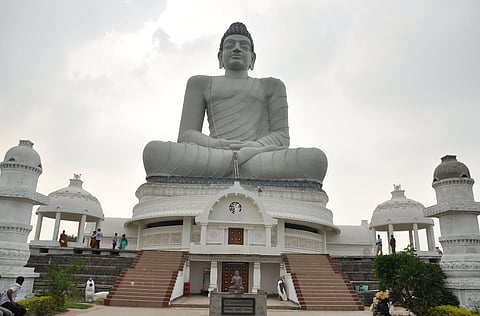

Creating multiple capitals so as to ensure balanced regional development, decongestion of capital cities and equitable wealth distribution geographically is not a concept unknown to the world. It is time-tested. South Africa has Pretoria (administrative capital), Cape Town (legislative capital) and Bloemfontein (judicial capital), while Netherlands has The Hague and Amsterdam, to mention a few.
Before we go into the selection of the three capitals of Andhra Pradesh, a little has to be said about the state’s three distinctive regions. North coastal Andhra, coastal Andhra and Rayalaseema have distinct cultures with different levels of development. Visakhapatnam, with a population of more than two million, has the advantage of being rich in infrastructure and is a natural choice for the executive capital, as it is cost-effective.
Rayalaseema, with its four districts, has tremendous scope to emerge as an industrial hub. Rich in mineral wealth, well-connected to metropolises like Bengaluru—the Chennai-Bengaluru Industrial Corridor runs through Anantapur and Chittoor districts—and the tremendous potential it has for tourism and international investment are some of its advantages. Giving it a fillip by making its prominent city, Kurnool, the judicial capital will not only address the longstanding aspirations of the Rayalaseema people but also boost development in the area.
As for Amaravathi, it is located on the southern banks of the Krishna river and has the advantage of being in the heart of the state’s agrarian basin. Richly watered by the Krishna, Godavari and Penna, it is a natural growth hub. Placing the legislative capital here ensures that this region continues to prosper, contrary to the false propaganda being unleashed by the TDP. The three-capital decentralisation system envisaged by the AP government is a revolutionary concept. A state cannot progress without the overall development of all the regions.
Three capitals in different geographical locations of the state would mean development would be evenly distributed and there won’t be a Maharashtra-type situation, wherein almost all the wealth and entrepreneurship is accumulated in its western coastal region, specifically Mumbai. After the bifurcation, the residuary state of Andhra Pradesh faced significant loss in terms of its erstwhile capital, Hyderabad. The Hyderabad that we see today was developed over the decades by people from all over the Telugu-speaking regions. The state now needs a new capital and building one from scratch involves huge costs, time and effort. Therefore, the government has rightly decided to evenly distribute the investment.
Three capitals will ensure that there will be massive waves of development in education, entrepreneurship, health, transportation, communication and other areas in these places. Amaravati would definitely develop, but so would other cities. This decision does not mean its destruction, as is being falsely propagated by former chief minister Chandrababu Naidu. It is unfortunate, though not unanticipated, that Chandrababu Naidu has been opposing the move. His development model had always been highly centralised. During his first term, he was so preoccupied with Hyderabad, or more specifically Cyberabad, that the neglect of other parts of the state earned him the moniker ‘Chief Minister of Hyderabad’.
This was one of the causes of his defeat in the subsequent elections. Even during his second term, he clung to the same mindset. He wanted to concentrate all resources in the proposed capital Amaravati. But the mandate of a state government and a CM is to govern and develop the entire state, not just a particular city. Chief Minister Jagan Mohan Reddy’s government has, on the other hand, focused on decentralisation of power and resources with a much deeper understanding and long-term goals. History tells us that generally, whenever a new state is carved out, the largest city is made the capital. We saw it happening in Uttarakhand with Dehradun being made the capital, or Jharkhand with Ranchi and Meghalaya with Shillong.
Therefore, it can easily be deduced that Visakhapatnam, which is by far Andhra’s largest and most modern urban agglomeration, is an ideal city to be the executive capital. Building that kind of infrastructure in Amaravati all over again would mean a heavy burden on the state exchequer and loss of valuable time. The CM also acknowledges that money has been spent in Amaravati, albeit with no work comparable to that of the level of a capital. The feelings of the people of Amaravati have also been catered for; therefore, Amaravati will continue to be the legislative capital. Kurnool being the judicial capital will also fulfil the long-pending demand of the Rayalaseema region for a High Court there. Benches of the High Court will also crop up as per requirement.
This system of having a High Court in a different city than the Executive Capital is a successful one. Uttar Pradesh has its principal High Court in Allahabad while its capital is Lucknow. Chhattisgarh has it in Bilaspur while the capital is Raipur and Madhya Pradesh has it in Jabalpur, though its capital is Bhopal. Having multiple capitals is good for big states like AP, allowing the government to keep its eyes open to regional aspirations and demands. Inclusive growth and eradication of regional disparity are very important for a government committed to the overall development of the state. Historically, there have been regional disparities in AP and it is not possible to correct this suddenly.
However, if we continue to ignore it and not deal with it head-on, it may backfire. The AP government has taken this issue very seriously and the three-capital system is an important step towards it. I would like to hail the efforts of CM Jagan Mohan Reddy for his vision. I am confident that this system will kickstart a process of rapid and inclusive growth in the state. I am also hopeful that this idea will also inspire others in the days to come. Everybody has a right to benefit from developmental efforts. The three-capital idea is a huge step in this direction.
Vijayasai Reddy V
MP. YSRCP Parliamentary Party Leader and National General Secretary
(venumbaka.vr@sansad.nic.in)